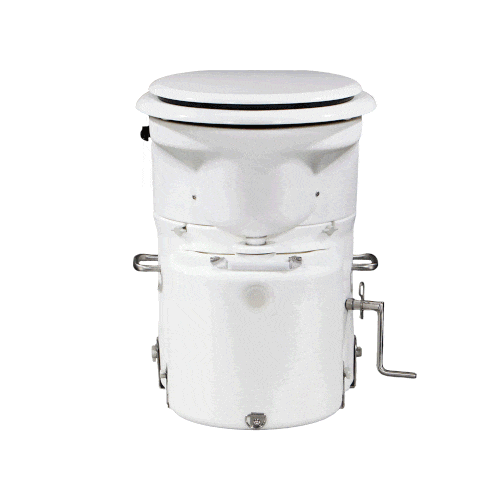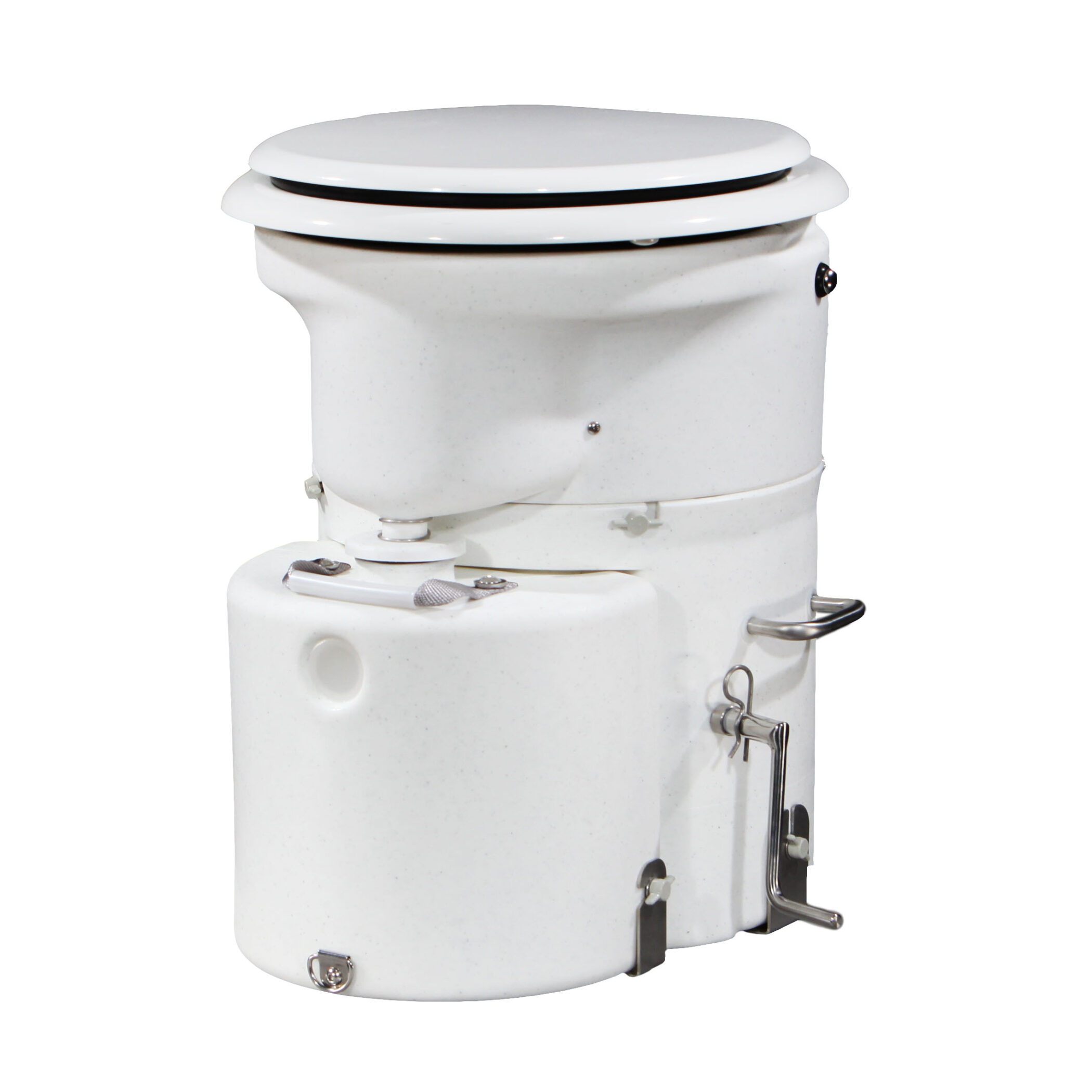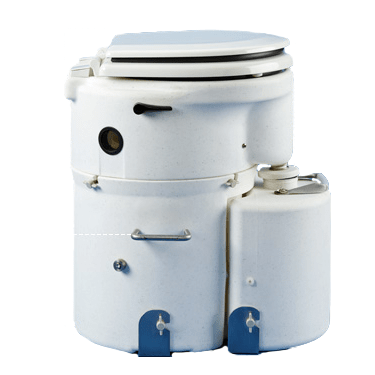The Air Head is the original and incredibly robust self-contained and compact dry toilet that’s ideal for canal boats, yachts, motorhomes, campervans and other off-grid locations.

With the Air Head toilet, you no longer need to worry about finding an ‘elsan’ disposal point and emptying a chemical toilet every couple of days, nor do you have to deal with any chemicals – it’s an entirely natural and eco-friendly process!
For almost 25 years, the Air Head has given you the freedom to travel further and to explore the wild places previously unexplorable to you. The solids tank only needs emptying after 50-60 uses which translates to 3-4 weeks of capacity for a couple of people.
It’s also odour-free, thanks to the separation of the liquids and solids, the turning mechanism and the low-powered 12-volt fan.
You can fit the Air Head into the tightest of spaces. It has an incredibly small footprint and is even available with a compact seat which saves a few centimetres on the depth required. The semi-flexible ventilation pipe can be run through the floor, wall or roof, depending on your situation.
And did we mention that it’s tough? Made from high-density roto-moulded, impact-resistant plastic and marine-grade stainless steel fittings, the Air Head will take the knocks and blows that other toilets won’t, protecting your investment for years to come!
Air Head is self-contained with an easy-to-remove 7-litre (2 US gallon) urine bottle on the front, and the main solids container behind that. The toilet bowl is designed to separate liquids and solids – urine flows to the front and then into the bottle, whilst solids are collected in the base.
When you set the Air Head up, you place a rehydrated coco coir block (peat substitute) in the solids container. After each solid use, turn the handle on the side once or twice – this breaks up the solids, coats everything with the coir, and aerates the mass. This action (along with keeping the urine away), massively reduces the odour. The fan draws air through and out so you can go to the toilet naturally, with no chemicals and no odours.
There’s a manual concealing screen covering the view to the solids container – if you’re just having a wee, leave it closed and it will direct any excess urine to the front. For solid use, open the screen.
When you’re looking for a compact, tough and simple compost toilet for your boat or vehicle (or the garden room!), the Air Head might be the ideal choice! Available with a standard or compact seat, there are also choices of fan housings to suit a variety of installations.




Air Head was designed and launched in the USA in 2001 and is now made in Portugal.
The Air Head is easy to use and look after. Incredibly well made and durable. Find out more by clicking on the links below:
No. The base (aka the solids container) of the Air Head is manufactured with the handle on one side or the other. The handle is actually slightly offset and doesn’t run directly across the centre. It is possible to purchase another base with a different handle position if needed.
By default, the Air Head is supplied with the turning handle on the right, as seen when you are standing in front of the toilet, looking at it (so on the left when you are sat on the toilet).
It’s not a simple process as it will involve drilling new holes into the top of your Air Head. Air Head don’t recommend customers attempt this.
Yes, although it doesn’t come with an adaptor as most people will be using it in a boat, camper van or motorhome, which will probably have a 12v circuit – ideal for the fan.
Yes, but… carbon filters can work well at eliminating odours, however, the other reason for venting to the outside is to remove excess moisture. Carbon filters won’t remove any moisture, so can increase condensation in the room. We don’t currently supply or recommend any specific make or type of carbon filter, but we know some of our customers have fitted them.
We don’t recommend it in the UK climate. Most solar vents have limited capability to run when the sun isn’t shining which makes them less than ideal in typical UK weather! If your fan stops working, there is a risk of a) detecting odours and b) attracting flies.
It is technically possible for composting to take place in the solids container (you have all the ingredients required – carbon, nitrogen, water and air), but most users won’t have the contents sitting in the solids container for a long enough period of time.
For most people, you would use the toilet until it is full, at which point some of the contents will have started breaking down, but a lot will still be ‘fresh’. This will need composting away from the toilet for an absolute minimum of six months, ideally twelve months.
You can find detailed dimensional drawings on the Air Head dimensions page. All models require a minimum of 488mm width to accommodate the full range of the turning handle. You can reduce this slightly by using the ‘wrench’ adaptor to replace the standard handle, but it will make turning the agitator slightly more awkward.
As little as possible! Most of the instructions for rehydrating coir blocks refer to their use in horticulture, but in an Air Head, you want to keep them as dry as possible. Some customers find that placing the coir brick in a ziplock bag and adding a small amount of water at a time works well. You can break the brick up, adding more water if needed. Warm to hot water (not scalding hot!) penetrates the coir quicker than cold water.
You can use any non-scouring cleaners as you would with a plastic bath or shower base. Scuff marks on the body of the Air Head can usually be removed with a ‘magic eraser sponge’.
The urine bottle should be rinsed out after each time it’s emptied. Stronger cleaners can be used occasionally to remove urine scaling (Ecover toilet cleaner has been recommended by some of our customers).
Our preferred method of dealing with the solids (faeces) from a urine-diverting compost toilet is always to compost them in a compost bin (see our page on composting) as they ‘close the loop’ and return valuable nutrients safely to the earth. However, there may be situations, such as in motor homes or boats, where it’s impossible to compost on the go or store anything for later composting at home or on land.
In these situations, you may be able to dispose of small amounts (under 7kg) in municipal waste bins or official council waste disposal sites (the waste will be classed as non-recyclable and is typically used in an energy recovery process) provided the contents are double-bagged and clearly labelled (you can buy ‘tiger bags’ for such a purpose). The contents are referred to as ‘offensive waste’ and come under the same waste classification as used nappies and adult incontinence pads.
If you have permission from a land-owner, you could also bury the contents in the earth. Make sure you are away from a water course, and ensure wildlife and other people can’t easily come into contact with your ‘gift’.
If you’re on a canal or river, never discharge urine or faeces into the water (we hope that’s obvious!), and don’t use the bins provided by the CRT (Canals and River Trust) as they prohibit compost toilet disposal in their bins (it’s a long story…).
Whatever method you choose, always dispose of solid waste safely and responsibly.
The outside diameter is 1.8″ (4.57cm) The inside is 1.5″ (3.81cm). The hose is fairly unique as it has a reverse exterior thread on it.
The Air Head Standard used to be referred to as the ‘household’ and the Air Head Compact was the ‘marine’. The names were changed to reflect a shift in the customer base.
The only difference is the overall depth of the toilet seat and lid – on the Air Head Standard, you’ll find a full-sized toilet seat, and in order to accommodate this, the hinges protrude beyond the rear of the toilet. With the Air Head Compact, the seat is shallower (front to back) and the hinges are inset into the body. This means the Air Head Compact model can be fitted about 3cm closer to the wall – ideal if your space is really tight.
Not sure which toilet is right for you, need a quote or want to know a little more information?
Help us advise you by telling us a little about your situation - or even better, give us a call to discuss options!
Alternatively, you can write us an email at:
or give us a call on:
Sign up to our newsletter to receive WooWoo news and offers
Like us on Facebook
Suppliers














